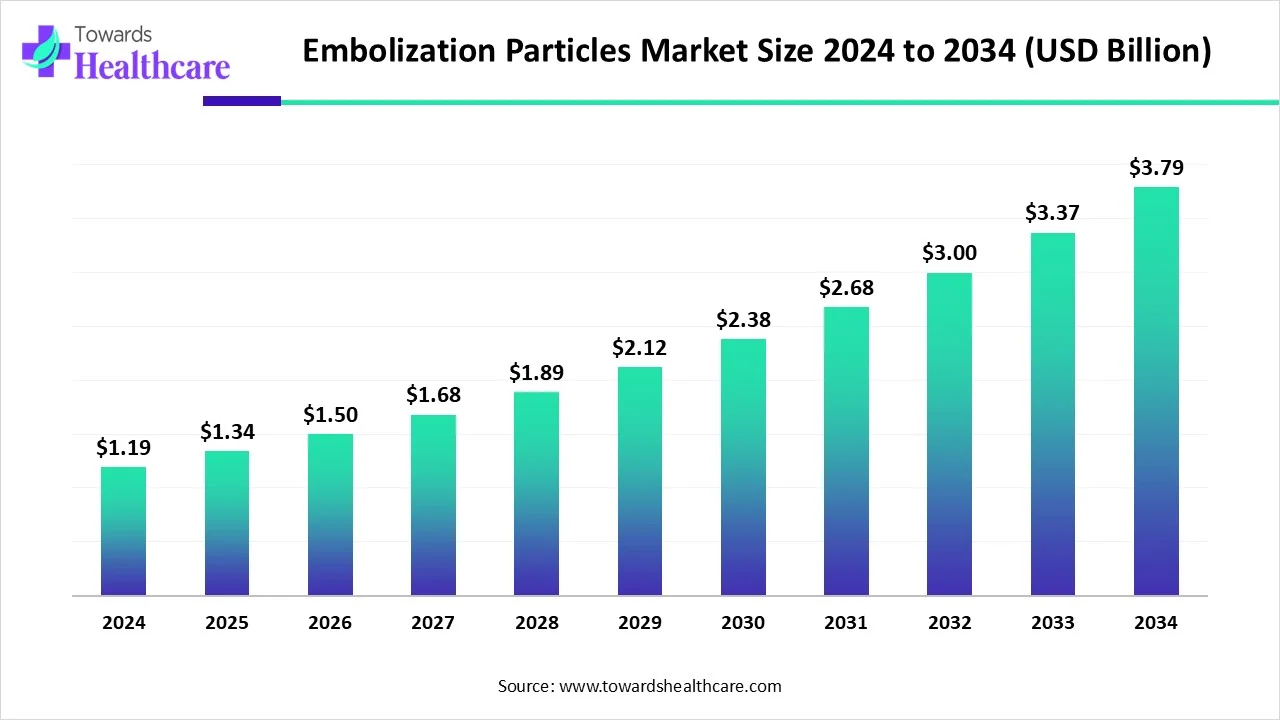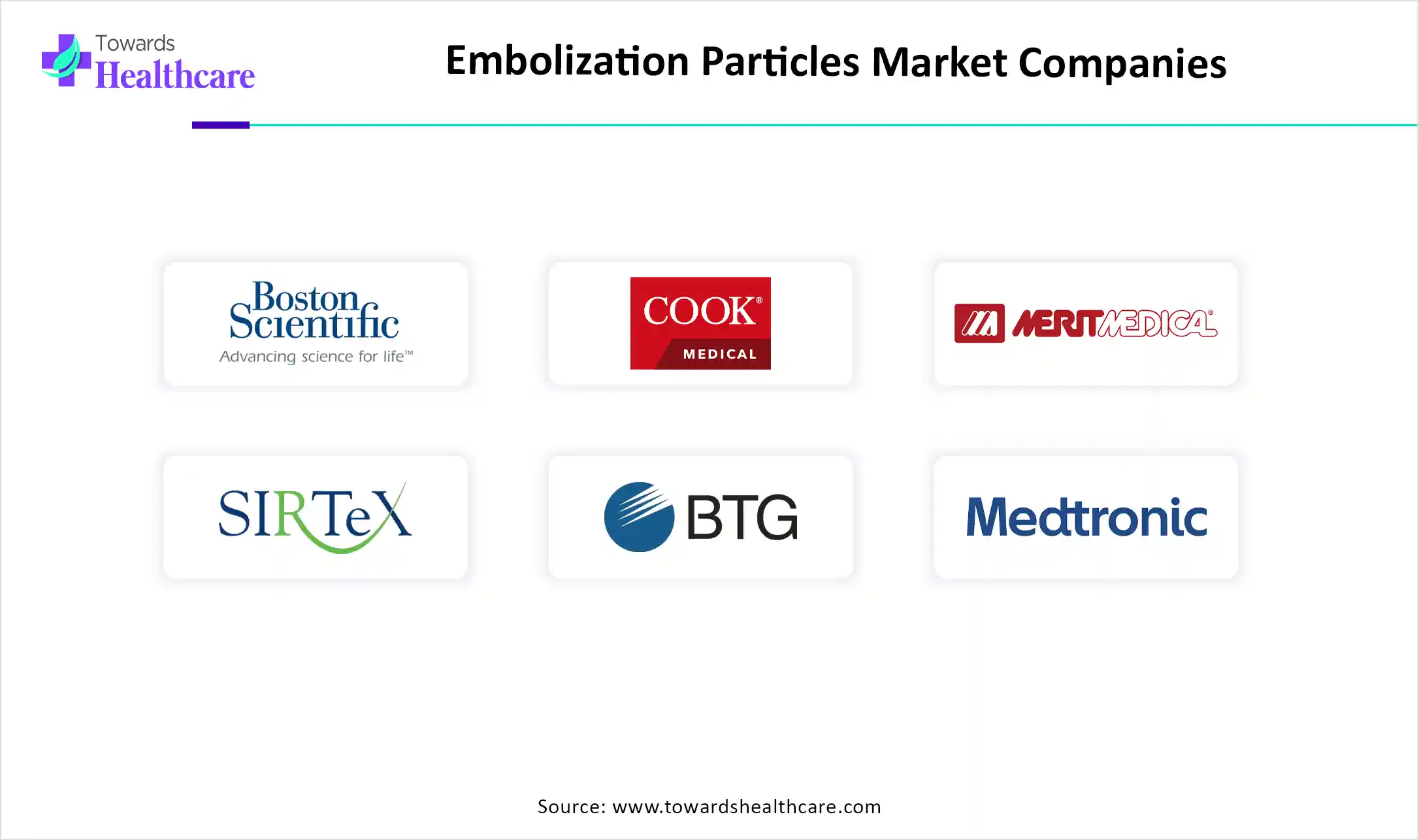December 2025

The global embolization particles market size is calculated at US$ 1.19 in 2024, grew to US$ 1.34 billion in 2025, and is projected to reach around US$ 3.79 billion by 2034. The market is expanding at a CAGR of 12.27% between 2025 and 2034.
The global embolization particles market is experiencing significant expansion with merging technological advancements. Several factors, including growing cases of different cancers, peripheral vascular diseases, and uterine fibroids, increasing demand for minimally invasive procedures with their enhanced outcomes, reduced toxicity, and increased target treatment, are fueling the market growth. As per its accelerating applications in targeted diseases, opportunities such as personalized medicines, including customized particle size, shape, and improved delivery systems, are boosting demand for minimally invasive procedures and overall market growth.

| Metric | Details |
| Market Size in 2025 | USD 1.34 Billion |
| Projected Market Size in 2034 | USD 3.79 Billion |
| CAGR (2025 - 2034) | 12.27% |
| Leading Region | North America |
| Market Segmentation | By Product Type, By Application, By Region |
| Top Key Players | Boston Scientific Corporation, Cook Medical, Merit Medical Systems, Sirtex Medical, BTG plc, Terumo Corporation, Guerbet, Medtronic, Varian Medical Systems, Inc., Kavya Pharma |
Primarily, embolization particles are tiny, particularly employed in a minimally invasive procedure termed embolization, which helps to block or minimize blood flow in specific blood vessels. In 2025, the global embolization particles market will be driven by the increasing number of cancer and target disease cases, resulting in a growing demand for minimally invasive procedures such as embolization, which are primarily used to treat tumors and vascular abnormalities. Moreover, nowadays, the market is focusing on embolic agents for different conditions, coupled with optimizing their biocompatibility, targeting specific vessels, and escalating their ability to deliver therapeutic agents. As well as they are also exploring innovative materials, particle sizes, and delivery approaches to boost outcomes and reduce complications.
Currently, Globe is focusing on broad applications of AI in different sectors, including embolization. However, accelerating the adoption of minimally invasive procedures and growing developments of novel embolization particles, such as drug-eluting beads and bioresorbable materials, are fostering the use of AI algorithms for the same. AI has a crucial role in the market by increasing accuracy, improving procedures, and enhancing treatment outcomes. AI-driven tools assist in the analysis of medical images, estimate treatment responses, and customize treatment plans, resulting in highly effective and robust embolization therapies.
Fostering Demand for Minimally Invasive Procedures and Technological Advances
Around the world, embolization is a minimally invasive technique that has raised demand due to its minimized patient trauma, rapid recovery, and less need for hospital stays. Several embolic agents, like Polyvinyl alcohol (PVA) particles, Tris-acryl gelatin microspheres (TAGM), are used in this. Besides this, the global embolization particles market is fueled by rising technological advancements, including drug-eluting beads, like chemotherapeutic drugs, for localized treatment of tumors, and optimization in imaging modalities are boosting the efficacy of treatment and expansion of applications.
Limitations for Cost and Safety
Emerging challenges across the market include for embolization to require well-developed devices, specialized embolic agents, and imaging support, which ultimately accelerate overall expenses. This rising spending generates limitations for patients. Along with this, sometimes this technique may create complications and side effects, and it also restricts the use of embolization.
Innovations in Material Science and Rising Applications
In prospects, there will be innovation in materials used in embolization, such as the development of biocompatible materials coupled with improved efficacy and safety profiles. These innovative materials are going to be widely employed in growing interest in areas like oncology, uterine fibroids, and prostate artery embolization. It is also focusing on the development of personalized procedures with tailored particle size, shape, and material properties for individual patient needs will be a key factor in the growth of the market.
By product type, the radioembolization segment was dominant with the biggest revenue share of the market in 2024. The dominance of the segment is propelled by the increasing cases of liver cancer, peripheral vascular diseases, and uterine fibroids, which often demand radioembolization particles. Moreover, rising technological advancements and ultimate growth in interventional radiology procedures by utilizing embolization particles are expanding the overall market.
By product type, the drug eluting beads segment is expected to register rapid growth over the predicted timeframe. Major benefits of DEBs are in targeted drug delivery approaches such as they can deliver chemotherapy drugs directly to target tumor sites, which enhances effectiveness with reduced systemic exposure and side effects. Also, there are many developments like smaller DEBs with improved penetration capabilities that are optimizing treatment results and accelerating their applications across numerous areas.
By application, the oncology segment dominated the global embolization particles market in 2024. In 2025 and the coming era, various types of cancer cases, especially liver, lung, and colorectal cancers, are and will be the major drivers of this segment. However, the growing adoption of TACE (Transarterial Chemoembolization) and TARE (Transarterial Radioembolization) is accelerating demand for embolization particles in different cancers with targeted treatments.
By application, the peripheral vascular disease segment is expected to be the fastest-growing in the upcoming years. Increasing incidences of peripheral artery disease (PAD), arteriovenous malformations (AVMS), and atherosclerosis are immensely demanding for embolization particle approaches. As well as, growing demand for minimally invasive procedures among patients and health professionals with enhanced benefits in recovery time and smaller incisions compared to open surgery is boosting the overall segment and market growth.
North America led the global embolization particles market in 2024. Due to the high burden of cancer, stroke, and peripheral vascular conditions, are important for fueling the demand for embolization treatment. Along with this, the region is experiencing major growth by fostering a well-developed healthcare infrastructure, comprising advanced diagnostic technologies and specialized healthcare professionals, which boosts the adoption and application of embolization techniques.
The US is experiencing enormous technological advancements with rising demand for minimally invasive procedures among patients and physicians due to their significant benefits over open surgeries. Besides this, consistent innovations and enhanced embolization particles, delivery systems, and imaging techniques are accelerating the efficacy and safety of these approaches, hence supporting in overall US market growth.
For instance,
The market is driven by the rising adoption of minimally invasive techniques, coupled with encouraging regulatory considerations in the form of approvals and simplifying processes for these approvals. Also, increasing investments in R&D and healthcare infrastructure to modernize healthcare facilities are expanding the market.
Asia Pacific is expected to grow at the fastest CAGR during the forecast period. As ASAP is experiencing the highest population growth connected with a variety of diseases, particularly different cancers, in developing countries like India, are a majorly demand for targeted, non-invasive procedures like embolization particles. As well as ongoing R&D activities for effective delivery systems and product launches are contributing to the overall ASAP market growth.
In India, the increasing cases of different cancers with other conditions related to vascular and arterial conditions, are acting as a major driver for the market expansion. Along with this, the Indian government is highly encouraging to enhance public health and promote medical tourism is also playing a critical role in the market development.
For instance,
In China, especially live cancer instances are growing and are majorly impacting the demand for embolization particles. Whereas, China is a well-known country for novel developments in targeted therapies in cancer and other conditions, including minimally invasive techniques are propelling the ultimate market expansion.
For this market,
Europe is estimated to grow significantly in 2025-2034, due to growing various conditions coupled with increasing demand and adoption of minimally invasive treatment, with its advantages across the diseases as compared to traditional approaches. Besides this, Europe has taken steps towards boosting awareness about health concerns, and embolization particles treatment in wide-range areas is also expanding the market growth.
Germany has adopted high healthcare standards, which assist in the adoption of advanced medical techniques, including embolization. Also, the German government has initiated and accelerated favourable reimbursement policies for embolization procedures are boosting the market growth.
Rising demand for targeted therapies in growing targeted diseases like cancer, along with enhanced healthcare infrastructure and escalating patient awareness in embolization choice, is driving the UK market growth. Besides this, accelerating efforts in R&D to develop new and enhanced embolization particles are significantly impacting the market expansion.
For instance,

By Product Type
By Application
By Region
December 2025
November 2025
November 2025
November 2025